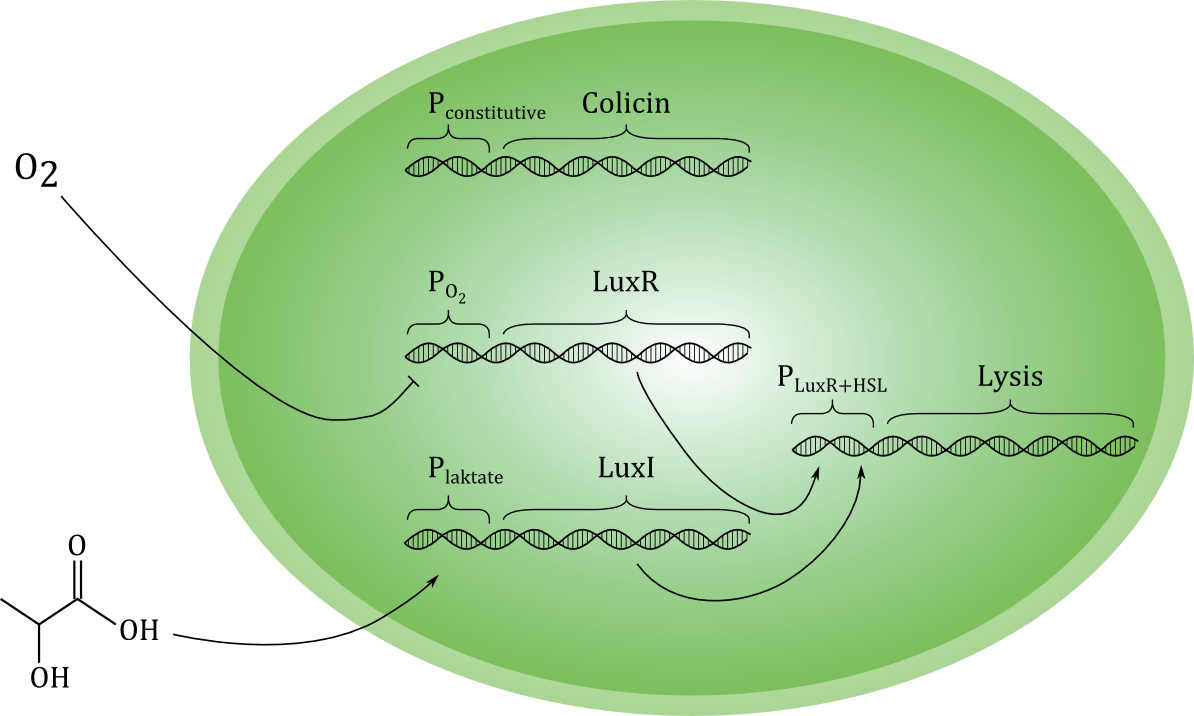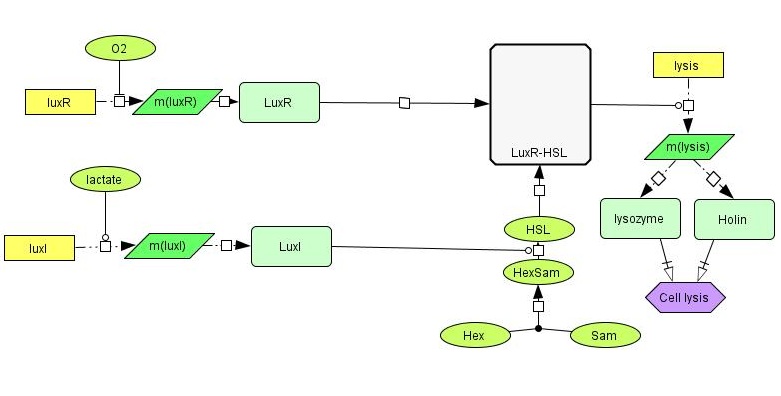Background
Cancer is the leading cause of death worldwide. In 2008 alone, 13% of all deaths (7,6 million people) were caused by cancer, and it is not likely that the number will decrease. Lifestyle diseases, for instance, are huge risk factors for developing cancer, and diseases like type 2 diabetes are increasing rapidly on a worldwide basis. [http://www.who.int/gho/publications/world_health_statistics/2012/en/index.html], [http://www.who.int/mediacentre/factsheets/fs312/en/].
One of the most challenging aspects of cancer medicine is the difficulty of drug delivery directly at the tumor area. We therefore wanted to develop a system for specific drug delivery, to show that one of the most challenging medical problems can be solved by using synthetic biology. So we decided to make a system responding to factors specific for cancer cells, but without being too complicated [http://mct.aacrjournals.org/content/4/10/1636.full].
In our system we want two different trigger factors, in order to lower the risk of releasing toxins in the healthy parts of the body. Our system is triggered by a low oxygen concentration and a high lactate concentration.
When the E. coli detects these conditions, our system will activate the lysis genes, and the toxin will be released.
Differentiated cells (“normal” cells) can produce high amount of lactate in an anaerobic environment, but this is not a normal environment for the cells in our body. Under normal circumstances, the differentiated cells will primarily metabolize glucose to carbon dioxide in the citric acid cycle (TCA), and have a very low production of lactate. Cancer cells behave differently. They produce large amounts of lactate regardless of the oxygen concentration in their surroundings [http://www.ncbi.nlm.nih.gov/pubmed/19460998], [http://cancerres.aacrjournals.org/content/58/7/1408.full.pdf+html]. The reason that we want to use oxygen as a trigger factor is that tumors exists in an environment deprived of oxygen [http://www.springerlink.com/content/a60537w7085574v4/].
Overview
Our goal for this years competition is to create a genetic circuit which enables E. coli cells to detect and attack cancer cells. To do this, the cells should produce a tumor inhibitor or toxin effective at killing cancer cells, and respond to environmental cues indicating the presence of cancer cells by undergoing [http://en.wikipedia.org/wiki/Lysis lysis], releasing the anti-cancer agent into the surrounding environment. In principle, bacteria could be used in "search and destroy" missions against cancer inside the human body. We wish to develop our genetic circuit as a proof-of-concept of one such strategy.
A sketch of our current planned design for the circuit is shown below.

A sketch of our planned genetic circuit
Ideally, the toxin should only be released if cancer cells are actually encountered, and never otherwise. To achieve this, the lysis-inducing part of the circuit should be regulated such that it is highly unlikely to activated in other situations. One possible way is to use a signal molecule that is solely associated with cancer cells to activate the lysis device. Another possibility is to use a combination of environmental cues that together indicate a high likelihood of cancer presence. We have chosen the latter strategy, and the environmental cues we aim to use are low O2 and high lactate concentrations.
Each of the two cues activates a separate gene, which encode different proteins. Together, these two proteins should activate the unit responsible for lysis. Therefore, if only one of the cues are present, the cell does not lyse, and toxin is not released in high levels. (Some leakage of toxin must be expected even under normal conditions with no activation of the circuit). Selective activation in the presence of cancer cells would be crucial for the concept to be effective in a medical situation.
As shown in the sketch, we plan to express the toxin-producing gene with a constitutive promoter. This means that the toxin production always be on. Ideally, the toxin should be maximally effective against cancer cells and minimally toxic to the toxin-producing cell. We have evaluated several candidate molecules. At the moment, we are leaning towards using the protein [http://proteopedia.org/wiki/index.php/Colicin_E1 Colicin E1].
Details
Below is a more detailed sketch of the circuit design (legend). The environmental cues oxygen and lactate regulate the production of two regulatory proteins, LuxR and LuxI. Oxygen inhibits the production of LuxR, while lactate activates the production of LuxI. LuxI in turn catalyzes the formation of a homo-serine lactone (HSL) compound from S-Adenosyl Methionine (SAM) and Hexanoyl-ACP (Hex). When both LuxR and HSL is produced, they combine irreversibly to form a complex which activates the promoter in front of the lysis device (BioBrick part <partinfo>BBa_K112808</partinfo>, designed by the University of California Berkeley iGEM 2008 team).

Detailed overview of our genetic circuit.
In order to have the presence of lactate activate the production of LuxI, we need a lactate-sensitive [http://en.wikipedia.org/wiki/Promoter_%28genetics%29 promoter]. We will attempt to isolate the lactate-sensitive promoter found in the [http://ecocyc.org/ECOLI/NEW-IMAGE?type=OPERON&object=TU164 lldPRD] operon of E. coli by PCR. However, the available literature indicates that this promoter [http://www.ncbi.nlm.nih.gov/pmc/articles/PMC205257/ is repressed under low-oxygen conditions] due to the action of the ArcA regulatory protein. A possible solution is using site-directed mutagenesis to change the nucleotide sequence at the probable binding site of ArcA on the promoter to reduce its binding affinity and abolish its regulatory effect.
Challenges
The goal of making bacterial cells detect and attack cancer cells present several challenges.
First, how can cancer cells be reliably and effectively detected? Early in the process after deciding on the goal, we considered using several human signalling molecules such as HGF and VEGF as cancer indicators, as these are known to be over-produced by tumors. However, we were unable to determine quickly if these would be able to enter and affect E. coli cells, due to their large size. In contrast, O2 and lactate are small molecules which are easily taken up by the cells, and are known to directly regulate the expression of various genes.
Parts
Promoters
To allow our system to work correctly, we need several different promoters. Of these, the most simple is a constitutive (always on) promoter in front of the toxin-producing gene. For this purpose, we have extracted the BioBrick part <partinfo>BBa_J23119</partinfo> from the iGEM DNA distribution kit. Second, a promoter having higher activity at low oxygen levels, similar to those found in tumors. As a candidate for this function, we will test the vgb promoter BioBrick part <partinfo>BBa_K561001</partinfo>. Thirdly, a promoter that is activated by lactate, a possible indicator of tumor cells in the vicinity (or strenous exercise!). We want to clone the lldPp promoter of the E. coli [http://ecocyc.org/ECOLI/NEW-IMAGE?type=OPERON&object=TU164 lldPRD] operon for this. Lastly, a promoter that is activated by a compound resulting from the activation of the previous two units. In our sketch, this compound is a LuxR-HSL complex, which can activate the promoters of several BioBrick parts, such as <partinfo>BBa_K145150</partinfo> or <partinfo>BBa_R0062</partinfo>.
Genes
LuxI is a acyl homoserine lactone syntase, an enzyme catalyzing the production of a homoserine lactone (HSL) from the precursors S-adenosyl methionine (Sam) and hexanoyl-ACP (Hex). The normal function of LuxI is as part of the bacterial lux system, a [http://en.wikipedia.org/wiki/Quorum_sensing quorom-sensing] system allowing cells in proximity to sense each others presence, estimate the local cell population and regulate bioluminescence. LuxI is available as the BioBrick part <partinfo>BBa_K092400</partinfo>.
File:NTNU 3OHSL.gif [http://partsregistry.org/3OC6HSL 3-oxohexanoyl-homoserine lactone] is synthesized by LuxI
LuxR is another protein in the lux system, and acts by binding to 3OC6HSL, the product formed by the catalytic activity of LuxI. LuxR-HSL then acts on gene promoters to regulate genetic expression. We will use the simultaneous expression of LuxR and LuxI leading to the the formation of LuxR-HSL to activate the lysis device which causes the cell to dissolve and release its produced toxin.
The lysis device was made by the UC Berkeley iGEM 2008 team. The genes are from the [http://en.wikipedia.org/wiki/Enterobacteria_phage_T4 bacteriophage T4] (a virus that infects bacteria). We will use it as-is, placing a self-chosen promoter in front of the part to control the initiation of cell lysis.

S-Adenoysyl-methionine (SAM)
 "
"







